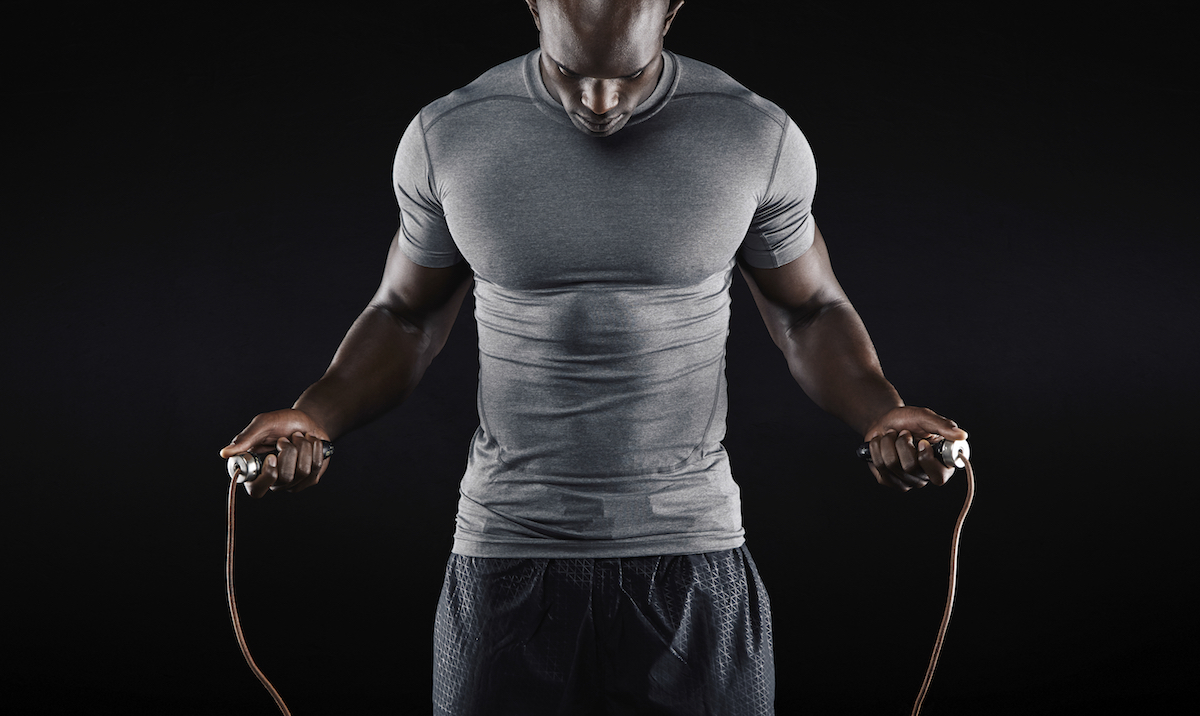A lot of people exercise to increase their muscle mass. Many periodization models call for there to be a period of time towards the beginning of the training year where an athlete does just that. This could be termed anatomic adaptation, general preparation, accumulation, etc. The length of these training phases varies, though 8-16 weeks seems fairly standard depending upon the sport or the level of the athlete. This type of training sees multi-joint exercises, moderate training intensities (70-80% of 1-RM range) and moderate volumes (three to five sets of 8-15 reps/set). The table below provides an example of this type of training. This kind of training, as long as the intensity is maintained (i.e. as the athlete becomes stronger, the weights increase) is an effective program for increasing muscle mass.
| Day One | Day Two | Day Three | Day Four | Day Five |
| Power cleans, 3x6x70%Back squats, 3×8-12×70-80%Lunges, 3×12-15 each leg
Romanian deadlifts, 3×8-12 Calves, 3×12-15 |
Push jerk, 3x6x70%Bench press, 3×8-12×70-80%Bent-over rows, 3×8-12
Military press, 3×8-12 Biceps/triceps, 3×12-15
|
Off | Power snatch, 3x6x70%Front squats, 3×8-12×60-70%Split squats, 3×12-15 each leg
Reverse hyperexntensions, 3×15-20 Calves, 3×12-15 |
Split jerk, 3x6x60% each legIncline press, 3×8-12Pull-ups, 3×12-15
Dumbbell shoulder press, 3×12-15 Biceps/triceps, 3×12-15 |
There are several reasons that this type of training can be found at the beginning of training plans. First, this type of training strengthens ligaments and tendons, which could help to prevent injuries later in the training year. Second, increased muscle mass provides the foundation to increase strength and power later in the year. In other words, first we increase muscle mass. Then we use that increased mass to increase our strength. Then we harness the increased mass/strength to improve power.
This approach works really well with certain sports. Here’s the problem though, this approach doesn’t work with every sport. There are a lot of circumstances where we don’t want to put on extra muscle mass for an athlete because they have to be able to run or jump with it.
If we’re not going to deliberately increase an athlete’s muscle mass, we still need to find ways to protect their ligaments/tendons, increase their ability to exert force, and increase their ability to do it quickly. There’s a few ways to do this:
- Implement metabolic conditioning. Generally this type of training does a poor job of increasing muscle mass. The weights used aren’t enough, there isn’t enough rest for the muscles to recover, etc. But, this does a great job of getting the athlete in shape and does a great job of developing those soft tissues.
- Train for strength year round. Strength is critical to speed, power, and agility. It’s also a skill, this means it has to be practiced year round.
- Train for power year round. Strength is important, but an athlete also has to know how to apply it quickly. This is also a skill and has to be trained year round.
- Increase the complexity of the strength and power exercise as the year progresses.
What follows is an example of an early off-season program that incorporates these principles.
| Day One | Day Two | Day Three | Day Four | Day Five |
| Back squats, 3×8-12×70-80%Romanian deadlifts, 3×8-12Bench press, 3×8-12×70-80%
Bent-over rows, 3×8-12 Military press, 3×8-12 |
Power clean, 3x6x60%Push jerk,3 x6x60%Clean pulls, 3x6x60% | Circuit, perform each exercise for 30 seconds, rest three minutes between each repetition of the circuit, repeat as many times as needed:KB swingsBW squats
KB one-handed swings Lunges KB one-handed swings Inchworms KB cleans Marches KB cleans Push-ups KB snatches Dips KB snatches Pull-ups |
In the above example, day one is the strength day. As the training is in the early off-season, it’s not very intense (70-80% of 1-RM). Day three is the power day. The final day focuses on the metabolic conditioning training. Now, if we wanted to focus on increasing muscle mass this program would look different:
| Day One | Day Two | Day Three | Day Four | Day Five |
| Back squats, 3×8-12×70-80%Romanian deadlifts, 3×8-12Bench press, 3×8-12×70-80%
Bent-over rows, 3×8-12 Military press, 3×8-12 |
Power clean, 3x6x60%Push jerk,3 x6x60%Clean pulls, 3x6x60% | Front squats, 3×8-12×60-70%Split squats, 3×8-12 each legGood mornings, 3×8-12
Back raises, 3×12-15 Calves, 3×12-15 |
Incline press, 3×8-12Superset: Dumbbell bench press and Pull-ups, 3×8-12 eachOne-arm dumbbell rows, 3×8-12 each arm
3-in-1 shoulders, 3×10 each Biceps/triceps, 3×8-12 |
If our focus is not increased muscle mass, then training still has to progress so that the athlete becomes stronger and more explosive as the season approaches. Starting with the example above (the three day a week example), the table below shows what this program might look like six months later. The exercises evolve in terms of their complexity, the intensity goes up, as the athlete gets in better shape there are more training sessions (two strength, two power, and one conditioning).
| Day One | Day Two | Day Three | Day Four | Day Five |
| Pause squats, 3×3-6×70-80%Partial deadlifts, 3×3-6Pause bench press, 3×3-6×70-80%
One-arm dumbbell rows, 3×4-8 each arm Dumbbell shoulder press, 3×4-8 |
Split clean, 3x3x70% each legClean pull + Power clean, 3×3+2×70%Dumbbell split jerk, 3×3 each leg | Circuit, perform each exercise for 30 seconds, rest three minutes between each repetition of the circuit, repeat as many times as needed:KB swingsBW squats
KB one-handed swings Lunges KB one-handed swings Inchworms KB cleans Marches KB cleans Push-ups KB snatches Dips KB snatches Pull-ups |
Eccentric split squats, 3×3-6×50-60%Pause Romanian deadlifts, 3×3-6Eccentric bench press, 3×3-6×50-60%
Pull-Ups, 3xMax Standing military press, 3×4-8 |
Power snatch, 3×3-4×70%Snatch pulls, 3x6x70%Power clean + Split jerk, 3×3+2×70%
|

